Open Source vs. Commercial AI: How to Choose (or Combine) Them
open-source solutions or leveraging commercial APIs.
Open Source vs Commercial AI Intro
Amid the explosion of AI tools and platforms, business leaders face a fundamental
choice: harness open-source models in-house or utilize commercial AI APIs. On
one hand, open-source can deliver deep customizability and lower marginal costs; on
the other, commercial solutions promise quick deployment, enterprise-grade support,
and cutting-edge updates. Some companies go fully open source for compliance
reasons; others lean on commercial offerings for advanced features and easier
scaling. This article explores both paths, helping you decide which approach—or
combination—best suits your goals.
Key Takeaways
- Open Source: Deep customization, lower marginal costs, and full data control—ideal for large-scale or regulated contexts.
- Commercial: Rapid deployment, enterprise support, frequent updates—but recurring usage fees can accumulate.
- A hybrid model often emerges, mixing open-source for certain tasks with commercial APIs for specialized or advanced features.
- Ultimately, strategic alignment, budget, data policy, and internal expertise dictate the right balance.
The Total Cost of Ownership: Open Source vs Commercial AI
Open-source AI can be an excellent choice if you handle large volumes of data or require stringent data governance. By hosting models in your own environment, you avoid per-request fees and maintain full control over your data pipelines and infrastructure.
Cost at Scale
While commercial APIs charge per call or per token, open-source models incur mostly fixed infrastructure costs:
- Predictable Spend: GPU clusters or cloud VMs have known hourly rates—no surprise overage charges.
- Economies of Scale: Running millions of inferences daily on self-managed servers can be 30–50% cheaper than equivalent API usage.
- Spot & Reserved Instances: Leverage discounted spot or reserved instances to further reduce compute expenses for non-critical workloads.
After the initial MLOps investment—cluster setup, monitoring, and maintenance—marginal costs per additional query drop dramatically.

Customization & Proprietary Advantage
Open-source frameworks empower you to tailor every aspect of the model to your domain:
- Architecture Tweaks: Add custom attention heads for specialized tasks—like geospatial pattern recognition in satellite imagery.
- Data Preprocessing: Integrate proprietary feature extractors or simulators directly into the training pipeline.
- Plugin Ecosystem: Utilize community-built extensions (e.g., Hugging Face transformers, custom tokenizers) or develop your own for niche requirements.
This deep level of control can yield proprietary performance gains and protect your competitive edge.
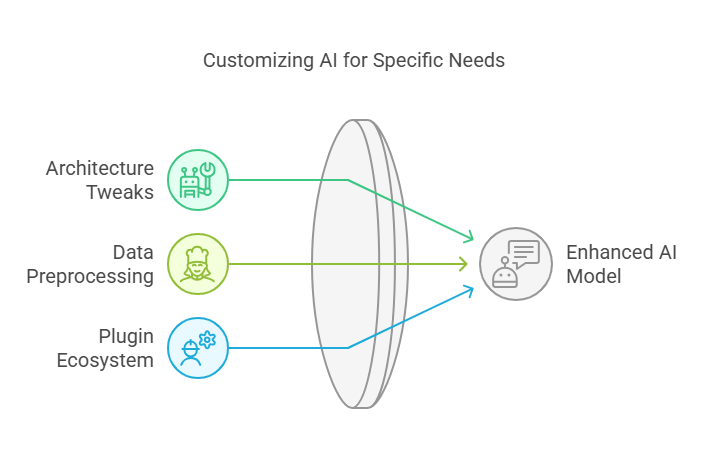
Data Governance in Open Source AI
Regulated industries mandate strict oversight of sensitive data. Open-source deployments ensure compliance and minimize risk:
- Data Residency: Keep all training and inference within your own firewalls or regional cloud zones.
- No Third-Party Logs: Guarantee that no external service can ingest or log confidential information.
- Custom Audit Trails: Implement fine-grained logging of data access and model predictions to satisfy GDPR, HIPAA, or SOC-2 requirements.
Full ownership of your AI stack gives stakeholders confidence that data governance policies are enforced end-to-end.

The Case for Commercial AI
Commercial AI solutions remove the heavy lifting of model hosting and maintenance, delivering cutting-edge capabilities through simple API integrations. When rapid time-to-market, top-tier performance, and enterprise-grade support are priorities, these offerings can be game-changers.
Immediate Deployment
Leading providers—OpenAI, Anthropic, Cohere, AI21—give you production-ready AI within hours:
- API-First Design: A handful of REST or SDK calls unlock chat, summarization, embeddings, and more.
- No Infrastructure Overhead: Forget managing GPUs or containers—just scale up API quotas as demand grows.
- MVP Acceleration: Startups can validate business cases quickly; enterprises can prototype new features without lengthy procurement cycles.
This speed lets you focus on integration and UX, rather than DevOps.
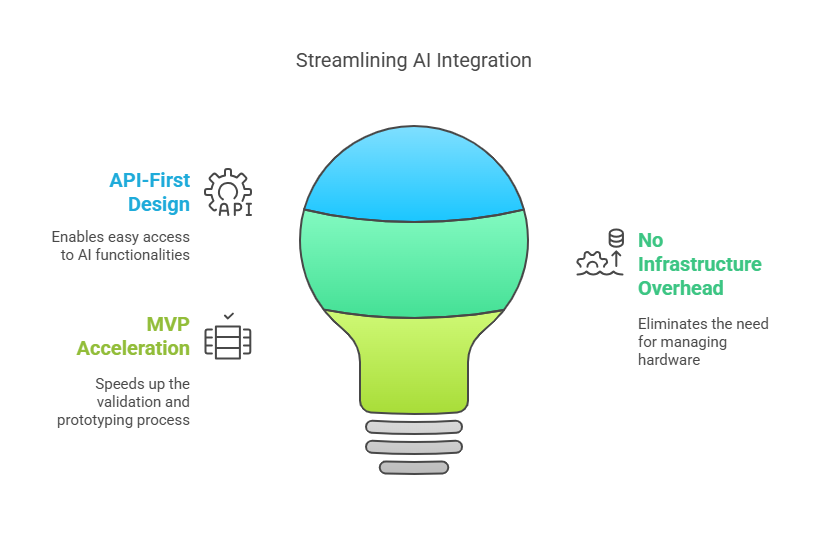
Cutting-Edge Performance
Commercial vendors invest heavily in research, delivering bleeding-edge model innovations:
- Latest Architectures: Access GPT-4, Claude 3, or proprietary multi-modal models long before open-source equivalents mature.
- Advanced Features: Benefit from instruction tuning, function-calling, and massive context windows without retraining.
- Continuous Upgrades: New capabilities and optimizations roll out automatically—no code changes required.
When differentiation depends on state-of-the-art AI, commercial APIs keep you ahead of the curve.

Support & SLAs
Enterprise-grade support ensures reliability for mission-critical applications:
- Service Level Agreements: Guaranteed uptime (often 99.9%+), latency commitments, and financial penalties for breaches.
- Dedicated Support: Customer success managers, priority incident response, and 24/7 technical assistance.
- Comprehensive Documentation: Best practice guides, SDK references, and worked examples accelerate integration.
This level of backing reduces operational risk and helps your team troubleshoot issues swiftly.
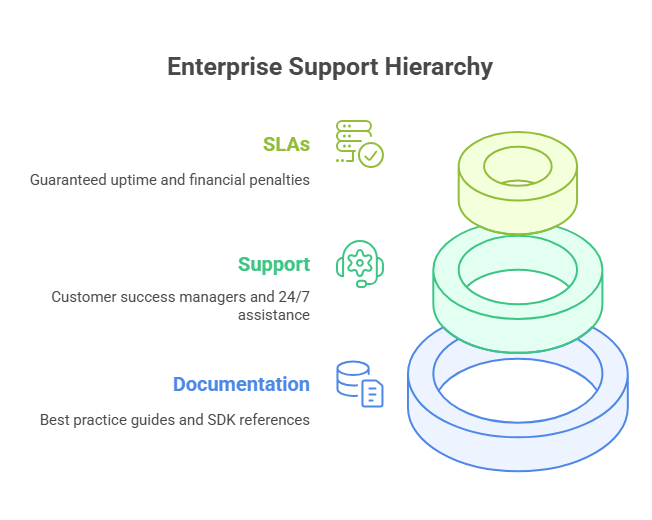
When to Blend Open Source and Commercial Models
Many organizations blend open-source and commercial AI to optimize cost, resilience, and feature set:
- Cost Management: Run high-volume classification or embedding tasks on open-source models; reserve commercial API calls for generative or advanced reasoning use cases.
- Failover & Redundancy: Maintain an on-prem open-source fallback if the commercial API hits rate limits or experiences downtime.
- Phased Transition: Kick off with a commercial API to validate market demand quickly, then incrementally migrate stable workflows to self-hosted solutions as requirements evolve.
By combining both worlds, you capture rapid innovation from vendors while controlling costs and ensuring resilience.

Evaluating Your Needs
Choosing between open-source, commercial, or a hybrid AI strategy requires a clear-eyed assessment of your organization’s resources, objectives, and constraints. Consider these four dimensions to guide your decision.
Budget & ROI
Up-front infrastructure and MLOps investments for open-source can be substantial, but marginal costs drop as query volumes rise. In contrast, commercial APIs charge per token or request, leading to predictable but potentially escalating monthly bills. Conduct a Total Cost of Ownership (TCO) analysis—factoring in hardware, cloud compute, maintenance, and API fees—to identify which approach delivers the best long-term return.
Technical Expertise
Self-hosting models demands specialized skills in container orchestration (e.g., Kubernetes), GPU management, distributed training, and continuous retraining workflows. If your team lacks seasoned MLOps engineers, a fully managed commercial API can offload operational complexity. Conversely, an in-house data science division can leverage open-source stacks to push experimental boundaries and tailor solutions deeply.
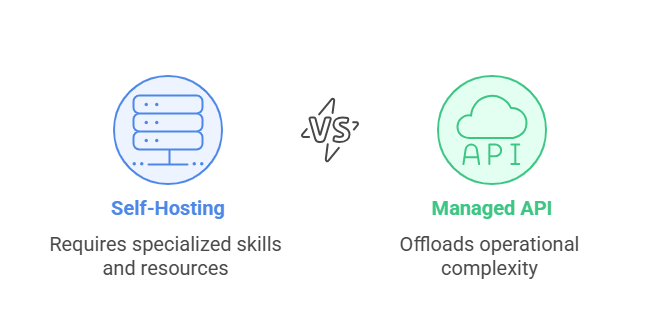
Project Timeline
When speed is paramount—such as proving an MVP or running a time-boxed pilot—commercial AI APIs can be live in hours. Open-source deployments, by contrast, require setup time for infrastructure, monitoring, and security. However, as your product matures and requirements stabilize, self-hosted models can offer greater flexibility and cost control for long-term projects.
Regulatory Constraints
Industries like finance, healthcare, and government often impose strict data residency and privacy rules (GDPR, HIPAA, SOC-2). If your vendor cannot attest to region-specific hosting or compliance certifications, open-source or specialized on-prem solutions may be the only way to guarantee data never leaves your control. Always verify third-party attestations before entrusting sensitive data to external APIs.
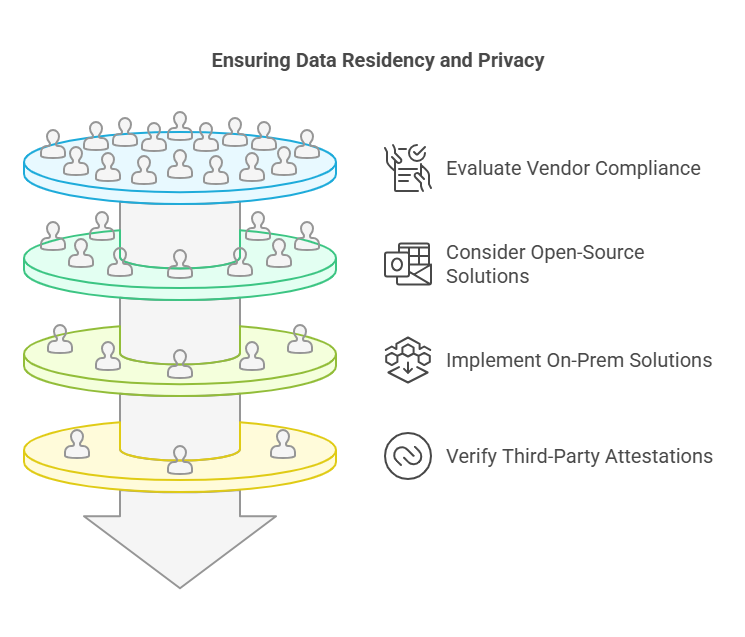
Conclusion
The choice between open-source and commercial AI depends on your business’s unique mix of budget, risk tolerance, domain specificity, and operational needs. Open source excels in customization, cost-efficiency at scale, and data control, while commercial APIs streamline deployments and provide enterprise-grade reliability and cutting-edge features. In practice, many teams embrace a hybrid model—using open-source solutions for core workloads and tapping commercial vendors when advanced or rapidly evolving capabilities are required.
By carefully evaluating your immediate requirements, budget constraints, data governance, and technical resources, you can craft an AI strategy that delivers the best of both worlds—paving the way for sustainable innovation, competitive advantage, and long-term success.
Having trouble deciding which path is right for you?
Our experts provide tailored solutions- whether you’re eyeing pure open source, commercial API’s, or a balanced hybrid. Map out a solution that aligns perfectly with your business goals.